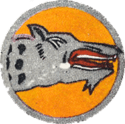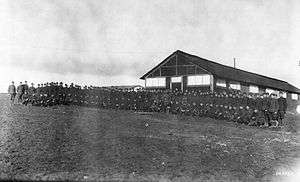49th Aero Squadron
| 49th Aero Squadron | |
|---|---|
|
Men (and mascot dog) of the 49th Aero Squadron, Souilly Aerodrome, France, November 1918 | |
| Active | 6 August 1917 – 22 March 1919 |
| Country |
|
| Branch |
|
| Type | Squadron |
| Part of | American Expeditionary Forces (AEF) |
| Fuselage Code | "Snarling Wolf" |
| Engagements |
World War I |
| Commanders | |
| Notable commanders | Lt. George F. Fisher[1] |
| Insignia | |
| 49th Aero Squadron Emblem |
 |
| Aircraft flown | |
| Fighter | SPAD S.XIII, 1918[2] |
| Trainer | Curtiss JN-4, 1917[2] |
| Service record | |
|---|---|
| Operations |
2d Pursuit Group Western Front, France: 14 August-11 November 1918[3] |
| Victories |
Air Aces: 0
|
The 49th Aero Squadron was an Air Service, United States Army unit that fought on the Western Front during World War I.
The squadron was assigned as a Day Pursuit (Fighter) Squadron as part of the 2d Pursuit Group, First United States Army. Its mission was to engage and clear enemy aircraft from the skies and provide escort to reconnaissance and bombardment squadrons over enemy territory. It also attacked enemy observation balloons, and perform close air support and tactical bombing attacks of enemy forces along the front lines.[5] After the 1918 Armistice with Germany, the squadron returned to the United States in March 1919 and was demobilized.[2]
On 16 October 1936, the World War I Aero squadron was consolidated with the United States Army Air Corps 49th Bombardment Squadron to preserve the lineage and history of the unit. Today, the United States Air Force 49th Test and Evaluation Squadron performs flight testing at Barksdale Air Force Base, Louisiana.[2]
History
Organization and training
Formed at Kelly Field #1, San Antonio, Texas on 6 August 1917. During its initial indoctrination training at Kelly Field, many squadron members were reassigned to other squadrons, however on 25 August, personnel from the 68th Aero Squadron were assigned to the 49th. After about a month of basic training as soldiers, the squadron was moved to the newly opened Kelly Field #2 where they began training with Curtiss JN-4 Jennys as a school squadron.[6][7]
On 16 November, training ended and the squadron moved back to Kelly Field #1 to await orders for overseas deployment. On 21 November, an additional 65 men were assigned to the 49th Squadron, and the unit entrained in San Antonio bound for Garden City, Long Island, New York.[6]
The squadron arrived in New York on 3 January 1918. Several weeks were spent at the Aviation Concentration Center, sailing for Liverpool, England on 9 January, arriving on 23 January. The squadron disembarked the ship the next day and marched to the Liverpool railway station where a train took them to Winchester, Hampshire, on the south coast of England. Winchester was reached that evening and the squadron detrained and marched to the Romsey Rest Camp where the squadron remained for a week. On 31 January the 49th Squadron was divided up into separate flights for training by the Royal Flying Corps in England. Flight "A" and "D" were assigned to the Castle Bromwich Aerodrome, Birmingham; Flight "B" was assigned to Bicester Aerodrome, Oxford, and "C" flight to Rendcomb Aerodrome, Cirencester. The flight officers wee ordered to the Third Air Instructional Center, Issoudun Aerodrome, France for combat training.[6]
The squadron was re-assembled at Castle Bromwich Aerodrome on 5 April where additional training was received until 24 June. From there the squadron departed for France, arriving at Issoudun for additional training on French aircraft. Several weeks were spent there before being assigned to the 3d Pursuit Group and transferring to Vaucouleurs Aerodrome. There the squadron received French SPAD XIII pursuit planes, then being transferred again to Gengault Aerodrome, Toul where the squadron was reassigned to the 2d Pursuit Group.
Combat Operations
Combat patrols began on 18 August when at 06:15 three aircraft took off from Toul. Two of the aircraft had engine problems and were forced to return, leaving Lt Buford alone. At 07:30 he encountered a German Rumpler biplane at 5,000 meters. Lt Buford engaged the enemy aircraft and got on the tail of the Rumpler and fired a long machine-gun burst. The Rumpler caught fire and he saw the plane go into a straight nose dive.[6][8]
On 23 September, the squadron moved to Belrain Aerodrome near Bar-le-Duc. On 4 October, a patrol of seven aircraft encountered a formation of six Fokkers in the region of Doulcon. Turning, several aircraft of the squadron moved into position to attack, while the remainder remained above. During the course of the combat, several other Fokkers attacked the high flight of the squadron. During the course of the combat, eleven enemy aircraft were seen to go down, the remaining aircraft turning back. One squadron pilot was lost in the battle and another squadron plane was damaged and had to make a forced landing on the friendly side of the lines after receiving several enemy bullets in his engine.[6][8]
Four of the 49th squadron planes encountered four enemy aircraft during a patrol on 10 October. The squadron attacked the enemy aircraft, seeing one begin to burn and falling in a straight nose dive and crashing to the ground. During the battle one of the squadron's SPAD's lost a wing and begin to fall, being followed down by a Fokker. The enemy aircraft was attacked and driven off. The last Fokker was attacked and it burst into flames, seeing it dive to the ground out of control.[6][8]
The last combat patrol was flown on 23 October when a formation of four squadron aircraft on patrol encountered four Fokkers. Attacking out of the sun and from above, the 49th Squadron shot down all four enemy aircraft without loss. On 6 November the squadron moved to Souilly Aerodrome, however bad weather led to no combat flying being made before the Armistice on 11 November.[6][8]
Demobilization
After the Armistice, members of the squadron began taking leave in France, with the organization standing down, although some cross-country flights were made. On 6 December orders were received from First Army for the squadron to report to the 1st Air Depot, Colombey-les-Belles Airdrome to turn in all of its supplies and equipment and was relieved from duty with the AEF. The squadron's SPAD aircraft were delivered to the Air Service American Air Service Acceptance Park No. 1 at Orly Aerodrome to be returned to the French. There practically all of the pilots and observers were detached from the Squadron.[9]
Personnel at Colombey were subsequently assigned to the Commanding General, Services of Supply and ordered to report to one of several staging camps in France. There, personnel awaited scheduling to report to one of the Base Ports in France for transport to the United States and subsequent demobilization. Finally, in March, the squadron boarded a ship bound for New York, and upon return to the United States, the men of the 49th Aero Squadron were demobilized and returned to civilian life.[9]
During its time in Combat, the 49th Aero Squadron downed 25 enemy aircraft, losing six pilots killed, wounded, or missing.[6]
Lineage
- Organized as 49th Aero Squadron, on 6 August 1917
- Re-designated: 49th Aero Squadron (Pursuit), July 1918
- Demobilized on 22 March 1919[2]
Assignments
- Post Headquarters, Kelly Field, 6 August-21 November 1917
- Aviation Concentration Center, 3–23 January 1918
- Air Service Headquarters, AEF, British Isles, 23 January 1918
- Attached to the Royal Flying Corps for training, 24 January-28 July 1918
- 3d Air Instructional Center, 2–28 July 1918
- 3d Pursuit Group, Air Service, 1st Army, AEF, 28 July-2 August 1918
- 2d Pursuit Group, Air Service, 1st Army, AEF, 2 August-7 December 1918
- 1st Air Depot, AEF, 7 December 1918
- Commanding General, Services of Supply, December 1918-March 1919
- Eastern Department, March 1919[2]
Stations
|
|
Combat sectors and campaigns
| Streamer | Sector/Campaign | Dates | Notes |
|---|---|---|---|
| Toul Sector | 30 June-11 September 1918;17 23 September 1918 | [10] | |
| |
St. Mihiel Offensive Campaign | 12–16 September 1918 | [10] |
| |
Meuse-Argonne Offensive Campaign | 26 September-11 November 1918 | [10] |
Notable personnel
|
|
DSC: Distinguished Service Cross; SSC: Silver Star Citation; KIA: Killed in Action[12]
See also
References
![]() This article incorporates public domain material from the Air Force Historical Research Agency website http://www.afhra.af.mil/.
This article incorporates public domain material from the Air Force Historical Research Agency website http://www.afhra.af.mil/.
- 1 2 Over the Front: A Complete Record of the Fighter Aces and Units of the United States and French Air Services, 1914–1918 Norman Franks, Frank W. Bailey. Grub Street, 1992. ISBN 0- 948817-54-2, ISBN 978-0-948817-54-0.
- 1 2 3 4 5 6 7 AFHRA 49th Test and Evaluation Squadron
- ↑ Series "H", Section "O", Volume 29, Weekly Statistical Reports of Air Service Activities, October 1918-May 1919. Gorrell's History of the American Expeditionary Forces Air Service, 1917–1919, National Archives, Washington, D.C.
- 1 2 3 Gorrell's History of the American Expeditionary Forces Air Service, Series M, Volume 38, Compilation of Confirmed Victories and Losses of the AEF Air Service as of May 26, 1919
- ↑ Maurer, Maurer (1978), The US Air Service in World War I, The Office of Air Force History, Headquarters USAF Washington
- 1 2 3 4 5 6 7 8 Series "E", Volume 8, History of the 47th, 49th and 50th Aero Squadron. Gorrell's History of the American Expeditionary Forces Air Service, 1917–1919, National Archives, Washington, D.C.
- ↑ Order of Battle of the United States Land Forces in the First World War, Volume 3, Part 3, Center of Military History, United States Army, 1949 (1988 Reprint)
- 1 2 3 4 Maurer, Maurer (1978) The US Air Service in World War I, Volume I, The Final Report and a Tactical History, The Office of Air Force History Headquarters USAF Washington,
- 1 2 Series "D", Weekly Statistical Reports of Air Service Activities, October 1918-May 1919. Gorrell's History of the American Expeditionary Forces Air Service, 1917–1919, National Archives, Washington, D.C.
- 1 2 3 United States War Department (1920), Battle Participation of Organizations of the American Expeditionary Forces in France, Belgium and Italy, 1917–1919, Washington, Government Printing Office, 1920
- ↑ Harvard's Military Record in the World War edited by Frederick Sumner Mead {1921} .p.117
- ↑ Military Times Hall of Valor Search, 49th Aero Squadron
External links

Wikimedia Commons has media related to 49th Aero Squadron.

